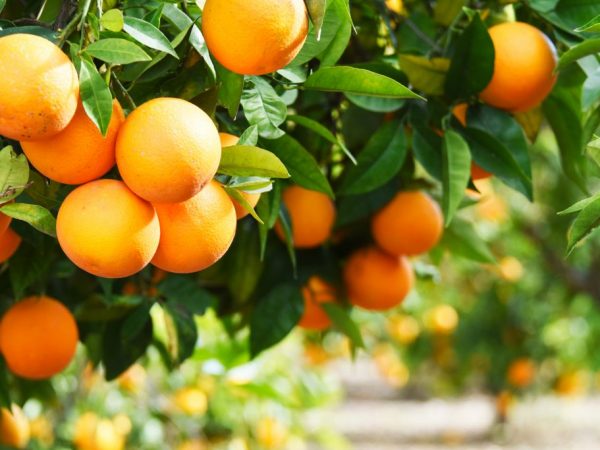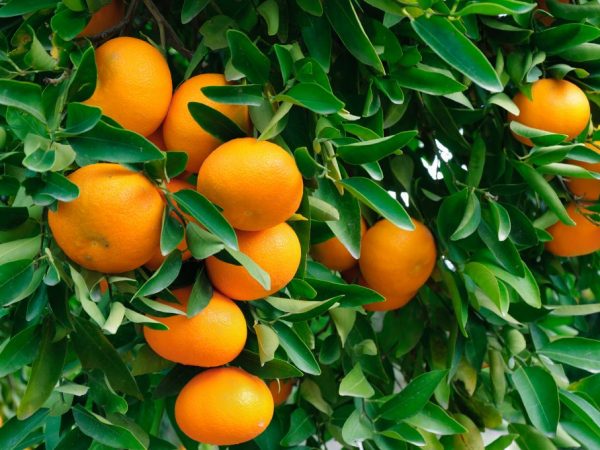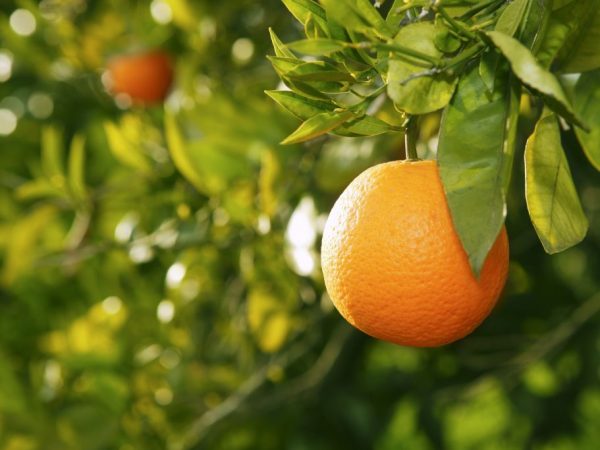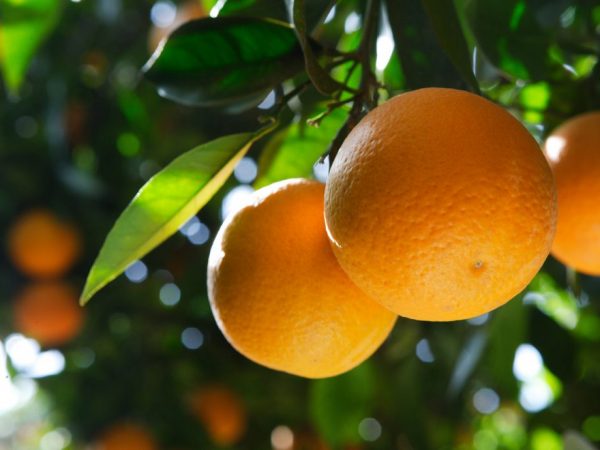How oranges grow
Oranges are fruit trees that have been cultivated by humans for several thousand years. Now they are known in all countries of the world. Outdoors, oranges grow in hot countries with tropical and subtropical climates.

How oranges grow
The origin of the orange
The name "Orange" comes from the Dutch (according to some versions - English) language. It translates as "Chinese apple". The homeland of the orange is China. It is the oldest fruit cultivated by humans. According to historical information, they began to grow it in the Celestial Empire as early as 2500 BC. e. But it is believed that the seeds of orange citrus came to China from India.
Orange trees were also grown in ancient Egypt, where citrus fruits were used as a medicinal product. The fruit came to Greece from India, after the campaigns of Alexander the Great, but did not receive much distribution. It was brought to Europe again by the Portuguese in the 15th century. No wonder in some languages the name sounds like "portogallo", that is, "Portuguese". Fruits came to the Mediterranean countries earlier, from the Middle East, after the campaigns of Christ. Now this type of citrus has become the most popular.
The orange has a hybrid origin, its ancestors are mandarin and pomelo. It remains unknown whether the crossing occurred naturally or artificially.
According to the botanical classification, the fruit belongs to the Rutov family, the Pomerantsev subfamily, the Citrus tribe. It is an evergreen tree that reaches a height of 10-12 m and can live up to 100-150 years.
Description of the orange tree
An orange tree grows up to 12 m in height, popular cultural rootstocks - up to 4-6 m.The dwarf species, which is grown at home in tubs, has a height of only 60-80 cm, greenhouse varieties - 2-2.5 m. The crown is compact, branches have spines up to 8-10 cm long. The trunk is covered with smooth brown bark.
According to the description, the orange tree grows for a long time, begins to bear fruit in 8-12 years, if planted from the seed. Small seedlings yield a harvest in 3-4 years.
Root system
There are no villi on the roots of the orange plant, which absorb moisture, mineral and organic substances from the soil. Instead, at the tips of the roots, there are special caps on which saprophytic fungi multiply. Through their mycelium, water and all the components necessary for nutrition enter the tree. First of all, these are phosphorus compounds. In return, mushrooms receive carbohydrates and amino acids.
The symbiosis increases the yield of the plant. At the same time, it becomes dependent on microorganisms. Mushrooms do not tolerate low temperatures, overdried soil, therefore the plant bears fruit only in warm climates, needs watering and irrigation. When transplanting, it is easy to damage the roots and mycelium - this manipulation should be carried out carefully. A young tree is transferred to a new place with a clod of earth.
Leaves

The tree has dark green oval leaves
The color of the leaves is dark green, oval in shape, with a pointed tip. The petiole is short, with a winged appendage. The leaf area is 10-15 cm, the edges are smooth, wavy or with shallow notches. The surface is smooth, evenly covered with short hairs. The leaf plate is fleshy, in its thickness there are glands that produce essential oils with a specific smell.
The leaves on the tree change gradually. Approximately 25% falls in February and March, and the same amount is lost throughout the year. The average lifespan of one leaf is 2 years. Young leaves are responsible for photosynthesis, old ones accumulate nutrients that are used for growth, the formation of flowers and fruits. Leaves tend to turn yellow in winter and then turn green again.
Fruiting orange
The fruit blooms and bears fruit all year round. This is a remontant plant; the tree contains flowers and fruits of varying degrees of maturity at the same time. Citrus fruits ripen mainly in late autumn. The main harvesting season begins in December and ends in February, but ripe fruits hang from the branches for about a year. Old fruits are used to collect seeds.
Flower
The orange bisexual flower has a diameter of about 5 cm. The structure of the flowers is simple, they consist of 5 elongated oval white petals, less often with a reddish tint. The pistil is long, located strictly in the center, surrounded by ten stamens.
Flowers parallel to the branch, sometimes tilting downward. They are collected in cluster-shaped inflorescences of 6 pieces. Flowering begins in March or early April. The bud stage lasts about a month. Flowers open at an air temperature of 16 ° C-18 ° C. The flowering period is short - 2-3 days. Cross pollination. Some varieties are self-pollinated. There are species without pistils, they bear fruit without pollination and reproduce without seeds.
Orange fruit
The fruit of the orange is called "hesperidium" or "orange". It looks like a berry, has 10-12 slices. They are separated by a thin skin. Each small orange slice consists of oblong sacs filled with juice. They are plant cells with swollen vacuoles. Closer to the center, in the thickness of the pulp, there are 1-2 beige bones with several embryos. There are also seedless varieties, their fruits are formed by the parthenocapic method, without pollination. A slice of such an orange is completely filled with juice bags.
From above, the orange fruits are covered with a peel, the thickness of which sometimes reaches 5 mm. The skin of the fruit consists of several layers. The top is called the zest. The color of the orange skin is orange, yellow-orange or red-orange. The bottom layer is white, loose, called "albedo" and is directly adjacent to the pulp. The peel is relatively easy to peel, even with your hands. For convenience, a longitudinal or transverse cut is made with a sharp knife, then the skin is removed without much effort.
Useful properties of an orange

Orange contains many nutrients
The soft and juicy orange fruit contains many useful substances. 100 g of product contains:
- proteins - 900 mg;
- fats - 200 mg;
- carbohydrates - 10.3 (including 8.1 monosaccharides and disaccharides);
- fiber - 1.4 g;
- pectin - 600 mg;
- organic acids - 1.3 g;
- minerals - 500 mg.
Vitamin composition:
- retinol (vitamin A) - 0.05 mg;
- thiamin (vitamin B1) - 0.04 mg;
- riboflavin (vitamin B2) - 0.03 mg;
- folic acid (vitamin B9) - 5 mcg;
- niacin (vitamin PP) - 0.2 mg;
- ascorbic acid (vitamin C) - 60 mg;
- tocopherol (vitamin E) - 0.22 mg.
The fruit contains all the main macronutrients: potassium, sodium, calcium, phosphorus and magnesium, - a large amount of trace elements: about 300 mg of iron, iodine, zinc, fluorine, manganese, etc. Orange has antioxidant properties, improves intestinal motility, increases the body's resistance to disease, and normalizes metabolism.
Fruits are recommended to be consumed every day with vitamin deficiency, increased fatigue, for the prevention of colds and other infections. They lower blood pressure, reduce weight, cholesterol levels, and oxalic acid in the blood. The sugar in a ripe orange is high, so it should be eaten with caution in diabetes. It is not advised to eat citrus before eating: it disrupts the normal absorption and digestion of food.
Varieties and uses of oranges
Currently, two large species groups of citrus fruits are cultivated:
- bitter and sour;
- sweet.
Bitter and sour have a sour taste with a pronounced bitterness. They are used in cosmetology and for the manufacture of certain medicines. Sweet oranges are suitable for food, which are also divided into 2 groups:
- light (ordinary and umbilical);
- red.
The main difference between these types is the shade of the pulp.
Ordinary light

Fruits are versatile in preparation
Plain or oval light oranges are the most common group. They have a light yellow juicy flesh with a sweet and sour taste. The peel is yellow-orange or yellow, thin, spliced with the pulp. The most popular varieties:
- Gamlin;
- Verna;
- Salustian.
Ordinary varieties are versatile. They are eaten fresh, used for the preparation of juices, canned food, preserves and jams, liqueurs. The skin is suitable for making candied fruits and essential oils. Oranges of this variety grow in countries such as Morocco, Spain, Greece, South Africa, China, India, Italy. They are also found in Abkhazia, Georgia, in the Crimea, near Sochi.
Umbilical Neville varieties
The main feature of this group of varieties is the reduced second fruit at the top. Sometimes it has a pronounced dent, resembling a navel. There are no thorns on the tree branch, unlike other species. The peel is thick, easily separated from the pulp. The mass of ripe fruits is 200-250 g, the taste is sweet, with a slight acidity and a pronounced citrus aroma. Main varieties:
- Washington;
- Late;
- Thomson;
- Navelina;
- Kara-Kara.
The popularity of navel oranges has grown in recent decades. This is due to a sweeter taste than other varieties. The application is universal, but in our area they are often eaten fresh. Citrus fruits of these species are grown in the USA, Brazil, Morocco, Spain, Greece, Italy.
Red oranges
The name of the orange varieties is associated with the red color of their flesh. Synonyms - bloody, bloody or Sicilian. The red tint is associated with the presence of anthocyanin, which is rare for citrus fruits. The species arose from a mutation that occurred naturally with the orange. In the Mediterranean countries, the plant has been cultivated for over 1000 years.
The trees are undersized, with an elongated crown. Fruit ripening takes longer than that of other varieties. They have a rounded shape, the skin is dark orange or brown. The pulp is red, but if the fruits are not yet ripe, it has a variegated appearance. The flowering bush is pink-red. The taste is sweet, with hints of honey, pronounced citrus aroma. Harvesting is late - from February to June. Main varieties:
- Moreau;
- Sanguinello;
- Tarocco.
Red fruits are eaten fresh; juices, jams, candied fruits are made from them. This variety grows in the USA (Florida, California), Italy, Spain, Morocco.
Interesting facts about oranges
Man has been growing a delicious citrus fruit for centuries. During this time, numerous interesting facts about the orange have accumulated. Here is some of them:
- In the late Middle Ages, the fashion for oranges spread among the aristocrats of various European countries. In temperate climates, they were grown indoors. In many languages, the name of the fruit sounds like "orange", so greenhouses are called "greenhouses".
- In the east, sweet citrus is considered a symbol of fertility, and in the west - a talisman of love and fidelity.
- In California, it is forbidden to take a bath and eat oranges at the same time. The acid in this fruit reacts with some of the ingredients in shower products and is harmful to the skin.
- The skin color of ripe oranges in the tropics is green. An orange tint appears due to a lack of sunlight or at an intermediate stage of maturation. When ripe fruits are brought from hot countries, they are specially treated with ethylene so that they acquire a characteristic shade: such fruits are better sold in supermarkets.
- Sour orange juice, getting into the stomach, becomes alkaline, therefore it is recommended to use it as a remedy for heartburn.
- Fruit aroma is the third most popular after chocolate and vanilla.
- Citrus seeds came to America during the second trip of Christopher Columbus and took root there well.
- About 13.85% of all orange fruits harvested on Earth go to juice. It is the most popular in the world.
- Orange tree sticks are used for manicure and pedicure.
- There are 35 million orange trees growing in Spain.
- World plantings cover 500,000 hectares, with an average of 30 million tons of fruit harvested, and in 2010, 63 million tons were harvested.
- Orange fruit has an anti-cancer effect, it is recommended to use it for the prevention of malignant tumors of the skin, lungs, mammary glands, stomach and intestines.
- The fruits improve vision, prolong youth, effectively reduce weight.
- Eating one large orange every day neutralizes the harmful effects of fast food and many animal fats.
- Zest, unlike pulp, lowers blood sugar levels.
- Jamaicans use citrus halves to clean floors, remove grease stains.
- In order for the fruit to withstand transportation, they are picked unripe. The fruits ripen during transportation.
- In Russia, this type of citrus appeared at the end of the 18th century and was considered exotic.
- There is a monument to the orange in Odessa. This little fruit once saved the city from decline. Russian Emperor Paul I decided to suspend the construction of the port. Odessans ordered 3000 kg of oranges to the tsar, after which money for further construction was allocated.
- The fruit is used to create hybrids. A tangerine crossed with it is called a clementine, and a hybrid with a pomelo is called a grapefruit.
Summarizing
Everything interesting about oranges allows you to choose the right variety. The sweet fruit is even grown in apartments. Unfortunately, trees do not bear fruit if they grow in cramped pots. They become beautiful ornamental houseplants. To get tasty fruit in temperate climates, the tree is grown in a greenhouse or large tub. In the summer they take him out into the street, and in the winter they hide him in the house.


